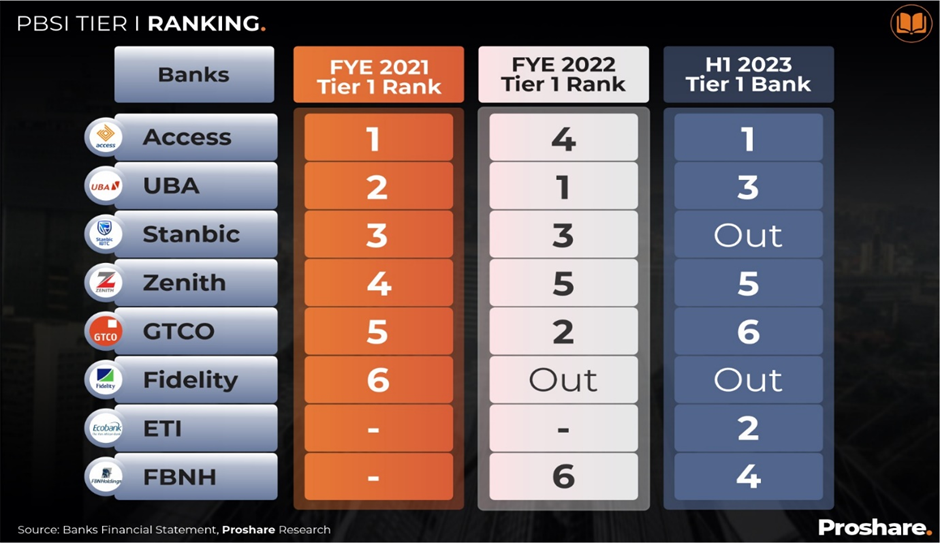H1’ 2023: Stanbic IBTC ,Fidelity Bank drop from the 2022 Tier 1 ranking,ETI now in.

Based on the H1’ 2023, Stanbic IBTC and Fidelity Bank have dropped from the 2022 Tier 1 ranking of the banking industry in Nigeria just as ETI has now joined tier . This is revealed by the Proshare Bank Strength Index (PBSI) targeted at eliminating arbitrariness in the classification of banks into tiers and developed to have a fit-for-purpose method of placing banks in Tiers., it is now easier to know the strength of every bank better than ever.
The PBS1 table also revealed that Access, UBA, Zenith, GTCO, ETI, and FBNH are currently Tier I banks on the strength of their performance across the assessment metrics, particularly E-banking, asset growth, and risk management so far in the year.
The state of play in WEMA, Union, FCMB, and Sterling Bank put them in the Tier II banks as of mid-year 2023.

Proshare Analysts classified banks based on their percentile score on the Proshare Bank Strength Index (PBSI). Banks with scores in and above the 50th Percentile are considered Tier 1 banks, while the rest are Tier 11 banks, and some are Tier 111 particularly those with negative or marginal shareholders’ funds .
In the maiden edition of the report, titled: The Case for Redefining Tier 1 Banks, the PBSI summarizes measures of Asset Quality, Profitability, and Liquidity. However with further insight, a fresh look at the 2021 metrics was broadened to allow its coverage to take on efficiency ratios, risk management, and digital income to incorporate Assets, Gross earnings (in absolute terms and on logarithmic scales), Capital Adequacy Ratio (CAR), Loans to Deposits Ratio (LDR), Cost to Income Ratio (CIR), Cost of Risk (CoR), Net Interest Margin (NIM), Non-Performing Loans Ratio (NPLR), Digital Income to Gross Earnings Ratio, and Independent Non-Executive Directors (INED) to Board Ratio. The banks with scores in the 50th percentile is thus ranked as Tier 1 (see table 1 below).

Given the delay in the release of some financials for the purposes of the FYE 2022 accounts, Proshare undertook a review of H1’ 2023 management accounts, and (see table 2 below)
.
The above initiative is to eliminate some arbitrariness in the classification of banks into tiers and . For instance , under the traditional model of banks, some of them gained an advantage by their asset sizes as Tier 1 banks would be those with larger assets above certain industry thresholds.
However , with banking today becoming more complex ,Asset or share capital-based metrics are believed to be insufficient to calibrate banks into Tiers.
According to the Proshare analysts , the problem with absolute figures, like asset size, gross earnings, and share capital, is that they could undermine the importance of efficiency and may disproportionately favour larger banks since the approach neglects the crucial aspect of asset quality. A similar oversight they believed could occur with Gross Earnings, as it does not distinguish between Interest and Non-Interest Income.
To provide a better approach to calibrating Tier 1 banks based on consultations and responses from several bankers on the 2021 methodology, the review in 2023 based on 2022 year-end and H1 2023 management accounts has resulted in a refinement in the assessment of the variables that put banks into buckets. . In its 2024 review, Proshare promises a further adjustment would be made concerning the contributions of banks to deposit premium payments to the Nigeria Deposit Insurance Company (NDIC). This is sequel to the fact that NDIC had adopted a risk-based review of insurance premium payments based on its assessment of the riskiness of the lending institution
Another adjustment that would be made would be consideration of the Financial Holding Company (Holdco) structure of banks. The different financial institutions under the Holdco structure of financial lenders create fresh layers of risk and potential non-interest incomes. A more detailed review of how these structures define bank ranking will appear in the next report as it reflects the transition of banking as distinct from banks




